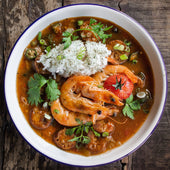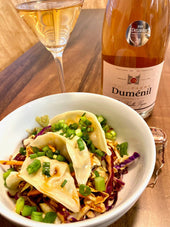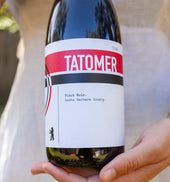
Port Calling

Port you say? What many generations of people used to embrace is now becoming less dominate in the American food scene. You capture a glimpse of it on the after dinner drink menu or in Grandma's shopping cart on Wednesday afternoons. Like fashion, wine trends may come and go, Port however paved the way for the fortified wine category. It still remains as one of the most iconic and recognizable wines in the same context as Bordeaux and Sherry.
Port "styled" wines can be made around the world, however real Port is made in the Douro Valley in Portugal, named after their famous town of Porto. Much similar to the term "Champagne" or "Sherry" the term is protected by the EU legislation.
What is Port?
Port is a sweet, red, fortified wine from Portugal produced from grapes grown in the Douro region. The styles range from Red, White, Rosé and from semi-dry to sweet to luscious. Over a hundred varieties of grapes are sanctioned for Port production although only five are widely planted and used. They are Tinta Barroca, Tinta Cao, Tinta Roriz, Touriga Francesa and Touriga Nacional.
What makes it sweet?
They don't add sugar to the wine to make it sweet. The addition of neutral grape spirit stops the fermentation process in the wine, leaving residual sugar in the wine.
How is Port made?
After harvest, port is traditionally fermented in lagars where people stomp grapes with their feet while the wine ferments. Today, most Port wineries use automatic lagars to "stomp" the grapes. The juice is stored and aged often in barrels and bottled depending on the style the winery is trying to achieve.
The Different Styles
Ruby Port
Deep color red Port which is the least expensive to produce. After fermentation, the wine is stored in tanks made of concrete or stainless steel to prevent oxidative aging and preserve the color. This style is meant to be drunk young and not suitable for aging.
Tawny Port
Barrel aged Port with oxidative, nutty and caramel flavors. They can achieve a mellow golden brown color. Tawny can be made without indication of age or with an age indication showing the nominal years in wood stated on the label. The categories are 10, 20, 30 and over 40 years.
Late Bottled Vintage (LBV)
Ports that are bottled four to six years after the vintage date. This provides convenience and access to a Vintage styled Port without the waiting. Typically ready to drink upon release.
Vintage Port
This is made entirely from the best grapes of a declared year (which is not always declared). Vintage Ports are aged in barrels for a maximum of 2.5 years before bottling and require another ten to forty years of aging in the bottle before drinking age. With minimal exposure to the barrel, the wine retains the dark color and fresh fruit flavors. These wines gain complexity and drink very nicely for many years after they are bottled. We recommend two from our selection: Martinez Vintage Port 1991 and Quinta da Romaneira 1987
Enjoyment
One of the great things about enjoying Port is that the wine will keep fresh for 2-4 weeks if kept in a cool dark place. Port is also food friendly and does not only have to be a dessert drink. So get inspired and try a few pairings yourself before Grandma does.
Famous Pairings
-Gouda, pecorino and comte cheese with Tawny Port
-Stilton, roquefort, gorgonzola cheese with Vintage Port
-Grilled sardines with blue cheese in phyllo tartlette
-Sea scallops with bacon
-Grilled duck breast with fig glaze
-Smoked pork shoulder or leg of lamb with mole poblano
-Chocolate torte
 Contributed by Monica Yu, Assistant Wine Buyer for Plume Ridge Bottle Shop.
Contributed by Monica Yu, Assistant Wine Buyer for Plume Ridge Bottle Shop.
Related Posts
-

Finding Your Perfect Chardonnay at Plume Ridge Bottle Shop
Chardonnay lovers, we see you, and we know choosing the right one can feel a little overwhelming (so many styles, so...
-

Pan-Seared Scallops with Lemon Butter Sauce
Some of our favorite chardonnays come from the Sonoma Coast, and today we have the perfect recipe to pair with a Son...
-

The Role of Terroir and Why Location Matters in Wine
When it comes to wine, we often focus on grape varieties, winemaking techniques, or the aging processes. But there’s...
-

Vegan Falafel Recipe
There’s something magical about falafel, the crispy-on-the-outside, tender-on-the-inside chickpea fritters that are ...
-

Wine Decanting Tips: When, Why, and How to Do It Right
There’s something undeniably elegant about pouring wine from a beautiful decanter. But decanting is about more than ...
-

Jar Salad Meal Prep Ideas
If you’re looking for a simple, healthy, and delicious way to stay on track with your meals, jar salads are the way ...
-

Wine Aging 101: Why Some Wines Improve Over Time
Why do some wines taste better after years in the cellar, while others are best enjoyed fresh? And what exactly happ...
-

5 Reasons Why Drinking Wine in YOUR Pajamas Is Totally Acceptable
There’s something magical about unwinding with a glass of wine, and let’s be honest, pajamas only enhance the experi...
-

Vietnamese Spring Rolls Recipe
Looking for a fresh, vibrant, and flavorful dish to try next in the kitchen? Try making Vietnamese Spring Rolls, or ...
-

Five Fascinating Wine-Related Stories
Here are five unusual and fascinating wine-related stories: 1. The Stolen Romanée-Conti Heist In 2014, thieves broke...
-

Seafood Gumbo Recipe
When it comes to comforting hearty meals, few dishes rival a well-made seafood gumbo. Hailing from Louisiana, gumbo ...
-

Vegan Butter Chicken Recipe
If you love the rich, creamy flavors of Indian butter chicken but want a plant-based version, this Indian Vegan Butt...
-

Dumpling Salad Recipe for Chinese New Year
Slide into the Year of the Snake with this Dumpling Salad. Also perfect to pair with Rosé Champagne, just in time fo...
-

Strawberry Matcha Pancakes
If you're looking for something a little different for breakfast, give this Strawberry Matcha Pancake recipe a try. ...
-

5 Fun Facts About Burgundy
Ancient Wine Heritage: The Burgundy wine region, known as "Bourgogne" in French, has been producing wine for over 2,...
-

Winery Spotlight: Chateau Cos d'Estournel
When it comes to French wineries with a rich history and a flair for elegance, Château Cos d’Estournel stands as one...
-

How to Make Mulled Wine
When the weather turns chilly and the holidays are just around the corner, there’s nothing quite like a cup of mulle...
-

10 Recipe Ideas for Leftover Thanksgiving Turkey
Thanksgiving is over, and now you're left with the most delicious problem, what to do with all that leftover turkey?...
-

Fact vs Fiction About Wine
Discerning fact from fiction in wine can be tricky because wine culture is filled with both valuable knowledge and m...
-

How to Make Loukoumades (Greek Donuts)
If you've ever visited Greece, chances are you've encountered loukoumades. They're delightful little doughnut balls ...
-

Understanding Wine Terminology: A Glossary for Newbies
Getting into wine can be a bit intimidating, but understanding some basic terminology can help you feel more confide...
-

Filipino Pork Adobo Recipe
Pork Adobo is probably the most well known dish to come out of The Philippines. Its known for its tender pork pieces...
-

Salt of the Earth Wines: A Taste of Sweetness
Salt of the Earth wines embody balance between time-honored tradition and modern innovation. Sourced from vineyards ...
-

Ways to Use Leftover Wine in Your Next Recipes
We've all been there. You open a bottle of wine for a special dinner, only to have a glass or two, and now you're le...
-

How-to Read a Wine Label
Reading a wine label can be daunting due to the variety of styles and terminologies used. However, understanding th...
-

The Impact of Climate Change on the Wine Industry
Climate change is reshaping the global wine industry in profound ways, impacting everything from grape growing to th...
-

Pão de Queijo: Brazilian Cheese Bread Recipe
If you've ever visited a Brazilian steakhouse, you’ve probably tried the delicious, cheesy goodness that is Pão de Q...
-

Exploring Lesser-Known Wine Varieties
Piedmont, Italy. Photo by Ken Zimmerman. Grignolino: This is Italy’s version of a Beaujolais (Gamay) located in Ast...
-

Tres Leches Cake with Fresh Strawberries
If there’s one dessert that can satisfy a sweet tooth while also offering a light, airy texture, it’s Tres Leches Ca...
-

The Impact of Oak on Wine: How Barrel Aging Influences Flavor
In wine aging, several types of oak barrels are commonly used, each imparting unique characteristics to the wine. Th...
-

Wine Etiquette: 5 Do's and 5 Don'ts for Enjoying Wine Like a Pro
Do's: Do Hold Your Glass by the Stem: Holding the glass by the stem prevents your hand from warming the wine, which ...
-

What is Biodynamic Wine?
You've probably noticed a recent trend in the wine world lately, it seems like a lot of wine shops have started to ...
-

Bouillabaisse Seafood Stew
Photo by Henry Perks There's nothing quite like a bowl of Bouillabaisse to transport you straight to the sunny shor...
-

Scallops with Sweet Corn & Shiitake Ragout
Take advantage of the fresh summer corn at your local market. This is a perfect dish as we transition from summer to...
-

How Should I Store My Wine?
If you're just getting started in your wine collecting journey, or even if you're a long time enthusiast, one of the...
-

How to Make The Perfect Aperol Spritz
My favorite summer time wine-based cocktail is the classic Aperol Spritz. This iconic cocktail has become synonymo...
-

What is Dessert Wine?
Dessert wine is a sweet, luscious wine that's usually enjoyed at the end of a meal. Unlike regular table wines, dess...
-

How to Make a Rosé Cooler
With the warm summer weather upon us, there’s nothing quite like a refreshing drink to cool down with by the pool....
-

Winery Spotlight: Frog's Leap
Nestled in the heart of Napa Valley, amid rolling vineyards and majestic oak trees, lies a winery with a unique an...
-

5 Fast Facts: Bordeaux
The region is renowned for its classification system, established in 1855 under Napoleon III, which ranks Bordeaux ...
-

What is Wine Sediment?
Have you ever poured yourself a glass of wine, only to find an unexpected surprise at the bottom of your glass? That...
-

Prosecco vs Champagne, What is the Difference?
When it comes to sparkling wines, people often think of either Prosecco or Champagne. While both are known for their...
-

5 Wine Tips on Buying Wine as a Gift Other Than from Chain Stores
Buying wine as a gift without going to a chain store can add a personal touch and show that you've put thought into ...
-

Winery Spotlight: Bodega Santa Julia
Located in the heart of Argentina's renowned Mendoza wine region lies Bodega Santa Julia, a winery that stands as a...
-

What Are Tannins?
Tannins have had a bad rap over the years, many wine drinkers claim that tannins were the cause of their "red wine ...
-

Fried Chicken and Wine Pairings
Fried chicken, the popular American comfort food, is one of the most popular meals across the globe. Tender juicy me...
-

Best Wines to Pair with Seafood
Wine and seafood is always a popular choice. While it's not that difficult to pair wine with seafood, it's also not ...
-

What Does Soil Have to Do with It?
The soil composition can influence the flavors of wine grapes in various ways. Here are five factors related to soil...
-

Is Wine Vegan?
We all know that wine is made out of grapes, but did you know it's more than just that? You might assume most, if no...
-

What is Natural Wine?
In the world of wine, there's a term that's been buzzing around lately: natural wine. But what exactly is natural wi...


















































